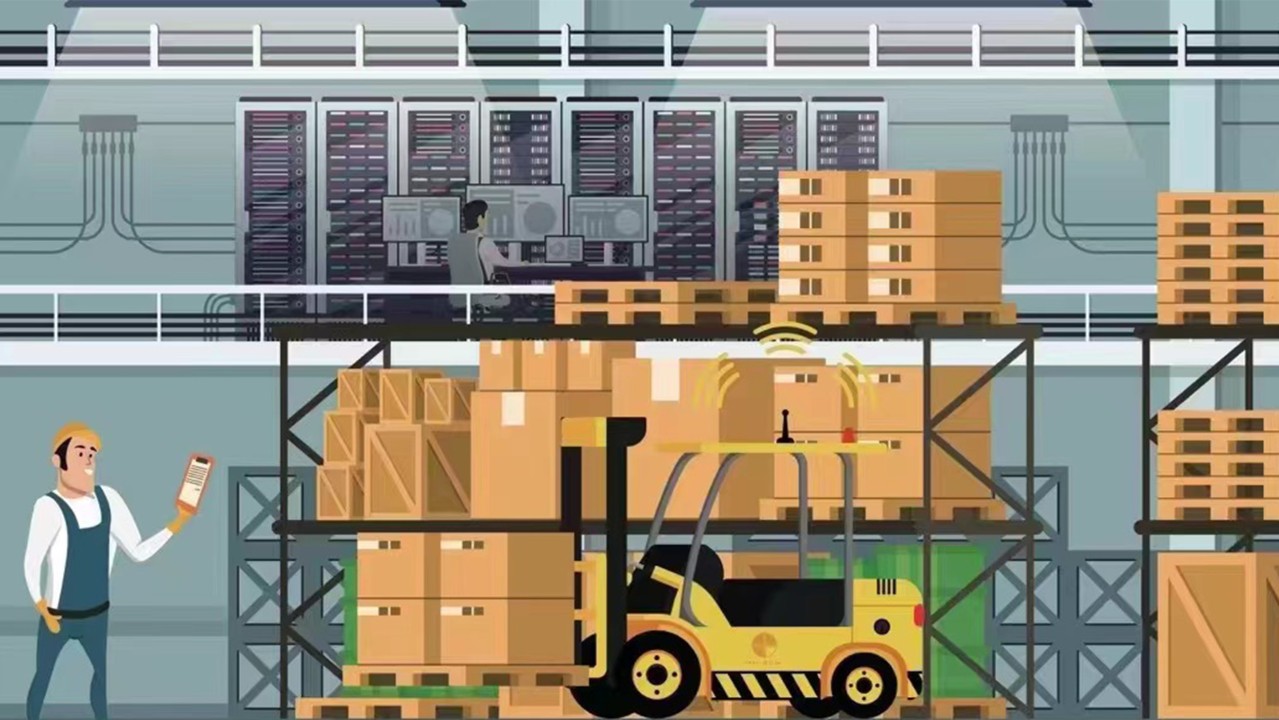Did you know that implementing smart warehouse technologies can increase operational efficiency by up to 30%? By integrating advanced automation, robotics, IoT, and data-driven systems, businesses can significantly optimize their warehouse management processes.
This integration not only streamlines operations but also enhances inventory control and supply chain optimization. With real-time visibility into inventory and processes, companies can make informed decisions, reduce errors, and improve customer satisfaction.
By leveraging these cutting-edge technologies, businesses can stay competitive in today’s fast-paced logistics and supply chain industry. The key is to adopt a comprehensive approach that encompasses all aspects of warehouse operations, from management to delivery.
The Evolution of Modern Warehouse Technology
The evolution of warehouse technology has revolutionized the way companies manage their inventory, ship products, and interact with customers. Modern warehouses are now hubs of efficiency and automation, far removed from the manual labor and paper-based processes of the past.
Traditional vs. Modern Warehouse Systems
Traditional warehouse systems relied heavily on manual labor, which often led to inaccuracies in inventory management. As one source highlights, “inaccuracies can result in lost sales, dissatisfied customers, and increased operational costs.” In contrast, modern warehouse systems leverage automation, robotics, and data analytics to optimize operations. This shift has significantly improved the accuracy and speed of warehouse operations.
Automation has been a game-changer, enabling warehouses to process orders more quickly and with fewer errors. Robotics, for instance, has improved the efficiency of tasks such as picking and packing. Data analytics provides real-time insights, helping managers make informed decisions.
Key Drivers of Technological Change
The key drivers of technological change in the warehouse industry include the need for increased efficiency, reduced labor costs, and improved customer satisfaction. As companies strive to stay competitive, they are adopting technologies that enable them to respond quickly to changes in demand and reduce lead times.
“The adoption of advanced technologies in warehouses is no longer a competitive advantage but a necessity for survival in the fast-paced logistics industry.”
Impact on Supply Chain Management
Modern warehouse technology has a significant impact on supply chain management. By enabling companies to respond quickly to changes in demand, reduce lead times, and improve overall customer experience, these technologies are crucial for maintaining a competitive edge. Efficient warehouse operations ensure that products are delivered to customers on time, enhancing customer satisfaction and loyalty.
The integration of advanced technologies in warehouses is transforming the logistics industry, making it more efficient, responsive, and customer-centric. As the industry continues to evolve, we can expect to see even more innovative solutions that further enhance the efficiency and effectiveness of warehouse operations.
Essential Components of Smart Warehouse Solutions
Modern warehouses are becoming increasingly sophisticated with the integration of advanced management systems and automation technologies. At the heart of smart warehouse solutions are several essential components that work together to optimize warehouse operations, improve efficiency, and reduce costs.
A robust warehouse management system (WMS) is crucial for streamlining processes, improving inventory accuracy, and enhancing customer satisfaction. A WMS provides real-time visibility into inventory levels, tracks the movement of goods, and automates tasks such as receiving, putaway, picking, and shipping.
Inventory control platforms are another vital component, enabling businesses to manage their stock levels effectively. These platforms help in tracking inventory in real-time, automating inventory reporting, and optimizing stock levels to meet customer demand.
Automation technologies, including automated picking tools and automatic guided vehicles (AGVs), play a significant role in enhancing operational efficiency. Automated picking tools reduce labor costs and improve productivity by minimizing the time taken to locate and retrieve items. AGVs, on the other hand, automate the movement of goods within the warehouse, reducing the need for manual handling and improving safety.
The integration of these components into a cohesive smart warehouse solution enables businesses to achieve supply chain optimization. By leveraging advanced technologies, companies can respond more quickly to changes in demand, reduce costs, and improve overall efficiency.
In conclusion, the essential components of smart warehouse solutions work together to create a highly efficient and responsive warehouse operation. By understanding and implementing these components, businesses can significantly enhance their warehouse management capabilities and achieve better inventory control.
Automated Storage and Retrieval Systems (AS/RS)
Modula Australia AS/RS technology is transforming the way warehouses operate, offering precision, speed, and reliability. By automating storage and retrieval processes, businesses can significantly enhance their logistics efficiency and reduce operational costs.
Automated Storage and Retrieval Systems (AS/RS) encompass a range of technologies designed to optimize warehouse storage and retrieval. Among these, Shuttle Systems stand out for their ability to efficiently move storage containers within a racking system, minimizing labor and maximizing space utilization.
Shuttle Systems
Shuttle systems are a type of AS/RS that use robotic shuttles to store and retrieve items from shelving systems. This technology allows for high-density storage and rapid access to inventory, making it ideal for operations with high inventory turnover.
Vertical Lift Modules
Vertical Lift Modules (VLMs) are another form of AS/RS that utilize a vertical storage system with computer-controlled retrieval. VLMs are particularly useful for storing heavy or bulky items, improving inventory management and reducing the risk of injury to warehouse staff.
Carousel Storage Solutions
Carousel storage solutions involve rotating storage systems that bring items to the operator, reducing the need for manual retrieval. This technology enhances picking efficiency and can be customized to fit various warehouse layouts and inventory needs.
By implementing these AS/RS technologies, warehouses can achieve significant improvements in automation and efficiency, leading to enhanced customer satisfaction and a competitive edge in the logistics market.
Implementing Advanced Warehouse Technology Solutions
As the logistics landscape evolves, companies are turning to advanced warehouse technology to improve operations. The implementation of these solutions is a multifaceted process that requires a strategic approach to maximize benefits.
Effective implementation begins with a thorough assessment and planning phase. This involves evaluating current warehouse operations, identifying areas for improvement, and selecting the most appropriate technologies to address these needs. By doing so, businesses can create a tailored plan that aligns with their operational goals.
Key Considerations in Assessment and Planning
- Evaluating current operational workflows and identifying bottlenecks
- Assessing the scalability of potential technology solutions
- Determining the total cost of ownership for new technologies
Once the assessment and planning phase is complete, the focus shifts to integration strategies. Seamless integration of new technologies with existing systems is crucial for maintaining operational continuity. This includes ensuring compatibility with current warehouse management systems (WMS) and enterprise resource planning (ERP) systems.
Another critical aspect of implementing advanced warehouse technology is staff training. Employees must be equipped with the necessary skills to operate and maintain new technologies effectively. Comprehensive training programs help minimize disruptions and ensure that staff can maximize the benefits of the new systems.
Best Practices for Staff Training
To ensure successful adoption, consider the following best practices:
- Develop comprehensive training programs tailored to different user groups
- Provide ongoing support and resources for continuous learning
- Monitor progress and adjust training as needed
By carefully planning and executing the implementation of advanced warehouse technology solutions, businesses can achieve significant improvements in efficiency, accuracy, and overall competitiveness in the logistics market.
Real-Time Inventory Management Systems
Effective inventory management is now more about real-time visibility than ever before. In the fast-paced world of logistics, having accurate and up-to-date information on inventory levels is crucial for making informed decisions and responding quickly to changes in demand.
Real-time inventory management systems provide companies with the visibility they need into inventory levels, order patterns, and stock movements. This enables businesses to optimize their inventory levels, reduce stockouts, and improve customer satisfaction. According to industry experts, “Real-time inventory management is no longer a luxury, but a necessity for companies looking to stay competitive in today’s market.”
“The key to successful inventory management lies in having real-time data at your fingertips, allowing you to make swift and informed decisions.”
Industry Expert
By implementing a real-time inventory management system, companies can gain numerous benefits, including reduced inventory costs, improved cash flow, and enhanced supply chain efficiency. These systems can also help companies to identify trends and patterns in their inventory levels, enabling them to make data-driven decisions about their stock.
The benefits of real-time inventory management systems can be summarized as follows:
- Improved inventory accuracy
- Reduced stockouts and overstocking
- Enhanced supply chain efficiency
- Better decision-making capabilities
In conclusion, real-time inventory management systems are essential for companies looking to improve their inventory control, logistics, and overall efficiency. By providing real-time visibility into inventory levels and order patterns, these systems enable businesses to make informed decisions and respond quickly to changes in demand.
Maximizing ROI Through Warehouse Technology Investment
Warehouse technology plays a pivotal role in driving business growth through improved operational efficiency. As companies continue to navigate the complexities of modern logistics, investing in cutting-edge warehouse technology has become essential for maximizing return on investment (ROI).
To effectively maximize ROI, businesses must conduct a thorough cost-benefit analysis when considering warehouse technology investments. This involves evaluating the potential costs, including initial investment, maintenance, and training expenses, against the anticipated benefits, such as enhanced efficiency, reduced labor costs, and improved customer satisfaction.
Cost-Benefit Analysis
A comprehensive cost-benefit analysis is crucial for determining the viability of warehouse technology investments. Key factors to consider include:
- Initial investment costs
- Ongoing maintenance and support expenses
- Training costs for personnel
- Potential efficiency gains
- Expected reduction in labor costs
By carefully weighing these factors, businesses can make informed decisions about their warehouse technology investments.
Performance Metrics
To assess the effectiveness of warehouse technology investments, companies must track key performance metrics. These may include:
- Inventory turnover rates
- Order fulfillment rates
- Customer satisfaction levels
- Operational efficiency improvements
By monitoring these metrics, businesses can evaluate the impact of their warehouse technology investments and make data-driven decisions to optimize their operations.
Long-term Value Creation
Focusing on long-term value creation is essential for ensuring that warehouse technology investments generate a strong ROI. This involves considering not only the immediate benefits but also the potential for future growth and improvement.
By adopting a long-term perspective, companies can unlock the full potential of their warehouse technology investments and drive sustained business success.
Future-Proofing Your Warehouse Operations
To remain competitive, it’s essential to future-proof your warehouse operations by leveraging the latest advancements in warehouse technology. This involves anticipating and preparing for future changes and challenges in the logistics and supply chain industry. By investing in advanced warehouse technologies, such as automation, robotics, and data analytics, companies can ensure that their operations are adaptable and resilient in the face of changing demand patterns, new technologies, and evolving customer expectations.
One of the key strategies for future-proofing is to focus on long-term value creation. This can be achieved by investing in employee training and development, fostering a culture of innovation and continuous improvement, and adopting technologies that offer scalability and flexibility. For instance, implementing automated storage and retrieval systems (AS/RS) can significantly enhance operational efficiency and reduce labor costs.
The future of warehouse operations is also likely to be shaped by emerging technologies such as artificial intelligence (AI), Internet of Things (IoT), and predictive analytics. These technologies will enable warehouses to become smarter, more automated, and more predictive, allowing for real-time monitoring and optimization of operations.
- Investing in employee training and development to enhance skills and adaptability.
- Adopting emerging technologies such as AI, IoT, and predictive analytics.
- Fostering a culture of innovation and continuous improvement.
- Implementing scalable and flexible warehouse technologies.
By taking a proactive and forward-thinking approach to future-proofing, warehouses can not only stay ahead of the competition but also drive long-term success and growth. It’s about creating a resilient and adaptable operation that can thrive in an ever-changing landscape.
Conclusion: Transforming Your Warehouse for Tomorrow’s Challenges
Transforming your warehouse for tomorrow’s challenges requires a strategic approach to investing in advanced warehouse technology. By understanding the essential components of smart warehouse solutions, companies can optimize their operations, improve efficiency, and reduce costs in the logistics process.
Implementing automated storage and retrieval systems, and focusing on real-time inventory management, enables businesses to stay competitive. Future-proofing warehouse operations and focusing on long-term value creation ensures that investments in warehouse technology generate a strong ROI.
Any warehouse can become a “smart” warehouse by introducing technologies that make sense for their business and processes. By continuously evaluating and improving operations, companies can stay ahead of the competition and achieve success in the ever-evolving logistics landscape.



































